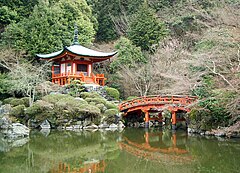Shingon buddhism
The shingon school (真言宗, shingon shū) is one of the main schools of Buddhism in Japan and the most important among the schools vajraiana, esoteric or tantric (mikkyō in Japanese), outside of India and Tibet.
The word "shingon" is the Japanese pronunciation of the Chinese term "zhēn yán" ('true words'), which in turn is a description of the Sanskrit word "mantra" (manasa traiaté: 'what frees the mind'). Shingon Buddhism arose in Japan during the Heian period (794-1185), when the monk Kūkai went to China, studied Tantric (Vajrayāna) Buddhism, returned armed with texts and works of art, and developed his own synthesis of the practice and esoteric doctrine, centered on the cosmic Vairochana Buddha.
The teachings of Shingon are based on the Maja-vairóchana-sutra and the Vashra-sékhara-sutra. Tantric Buddhism focuses on rituals and meditative processes that lead to enlightenment. According to the shingon, enlightenment is not some distant and distant reality that may take eons to reach, but rather our birthright, a real possibility throughout this lifetime. With the help of a true teacher and through correct training of body, speech and mind, we can reclaim and release this enlightened capacity for our own good and for the good of others.
In the shingon it is said that Vairochana Buddha is in all things. The goal of the shingon is the knowledge that one's nature was identical with Vairochana, a goal achieved through meditation and ritual practices. This knowledge depends on receiving the secret doctrine of shingon, transmitted orally by the teachers of the school to their initiates. Both the body and the speech and mind participate in the process: the body through devotional gestures (mudra) and the use of ritual instruments, speech through sacred formulas (mantra), and the mind through meditation.
There is a distinction between Shingon and all other schools of Tantric Buddhism that survive in Tibet, and that is the use of calligraphy, rather than pictorial representations, to represent the Buddha figures in their mandalas. An ancient Indian script known as siddham is used to write the mantras and draw mandalas.
The central sacred place of Shingon Buddhism is located in a valley at an altitude of 800 meters, surrounded by the eight peaks of Mount Koya, in a place believed to be planted with lotuses, next to the town of Koya, where it has been built a university for the studies of Shingon Buddhism and 120 temples, many of which offer accommodation for pilgrims. The temple built on the site and residence of the leader of Shingon Buddhism is called Kongōbu.
Contenido relacionado
The great Dictator
Samaria
Maximilien Robespierre


